EMD: GP7
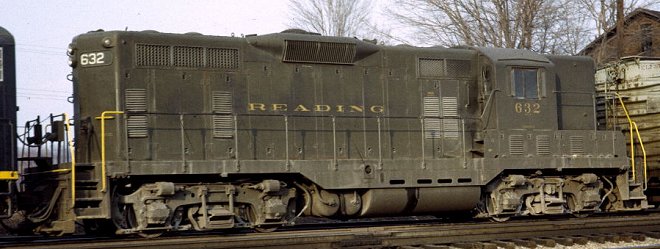
The Reading rostered a total of 44 EMD GP-7 locomotives. These 1500 horsepower "road switchers" entered into service between July, 1952 and October, 1953 as noted in the table below. The majority of the units lasted until late 1974, when they were retired due to the Reading's acquisition of their GP39-2 and MP-15 locomotives. Two units left the roster prior to 1974: #663 was the more famous of the two - she was the one that rolled into the tunrtable pit at the Saucon Creek Engine House, while #612 was a victim of the fire at the Gettysburg Freight House in 1966. 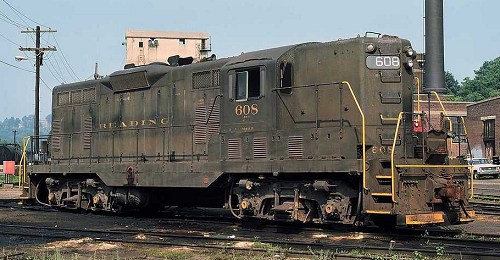
The image at left is representative of the as-delievered appearance of units #600 through #636, which were intended for freight service and equipped with dynamic brakes. Units #660 through #666 were acquired for secondary passenger service, and were not equipped with dynamic brakes, and thus their long hoods had a smooth appearance, as can be seen in the photo of #665 below. Due to their passenger service role, these locomotives were equipped with steam generators. During their service on mainline freight, the GP-7s could be found most often working between Allentown, Bethlehem, Rutherford and Darby Creek. It was rare to see them assigned to Newberry or Jersey City runs, or on the Bethlehem Branch. The passenger GP-7s were most often seen on Philadelphia-Reading and Allentown-Harrisburg trains, as well as some of the Philadelphia-area branch lines. Once the Budd RDCs came on the scene iin 1962, the passenger Geeps were assigned to Saucon Creek and the nearby Bethlehem Steel plant. As the second-generation diesels came on line in the mid-1960s, the GP-7s were relegated to branch line and yard service, with most of the units eventually being retired/sold in 1974 as noted above.
The following table shows the various in-service dates for the GP-7 locomotives:
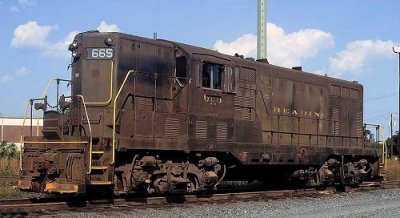
| Road No. | Built Date |
| 600 | 8/52 |
| 601-603 | 7/52 |
| 604-608 | 8/52 |
| 609-624 | 5/53 |
| 625-636 | 10/53 |
| 660-666 | 6/52 |
MODELING NOTES: These two photos show the GP-7s in their as-delivered Pullman Green paint scheme; however, the units have obviously been in service for some time - note how the paint has faded, and how some areas along the body are more weathered than others. Also, it's the details that make the difference. In these two images, note details such as the curved "L" grab iron on the short hood of #665, the yellow painted roller bearing caps, the spark arrestors on #608, and the fact that only one grab iron on the short hood of #608 is painted yellow. Small things like this, as well as additional details like the MU and air hoses, can really make your model stand out.
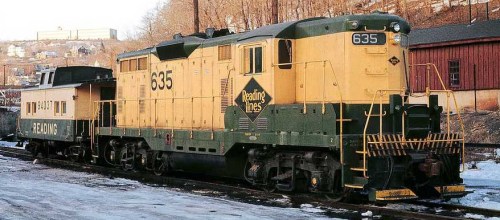 Since so many of the GP-7s survived into the early 1970s, many of them were repainted into the "second-generation" green and yellow paint scheme. There were two variants of this scheme applied to these locomotives. The most common application is shown in the photo of #635 at right. This version was applied to the following units: 607, 619, 626, 629, 631, 633, 635, 636 and 664. HOWEVER, even within this version, there is some slight variation. On some units, the entire long hood is painted yellow, as in the photo at right. On others, there is a very narrow strip of green along the bottom of the long hood, as can be seen in the detail photo of #626 below. Consult with prototype photos of the unit being modeled to be certain of the correct application.
Since so many of the GP-7s survived into the early 1970s, many of them were repainted into the "second-generation" green and yellow paint scheme. There were two variants of this scheme applied to these locomotives. The most common application is shown in the photo of #635 at right. This version was applied to the following units: 607, 619, 626, 629, 631, 633, 635, 636 and 664. HOWEVER, even within this version, there is some slight variation. On some units, the entire long hood is painted yellow, as in the photo at right. On others, there is a very narrow strip of green along the bottom of the long hood, as can be seen in the detail photo of #626 below. Consult with prototype photos of the unit being modeled to be certain of the correct application.
The second variant on the green and yellow paint scheme, which included a broad green stripe along the entire locomotive as seen below, was applied to locomotives #623 and #636. Also note in these two photos how both the yellow and green paint fade over time.
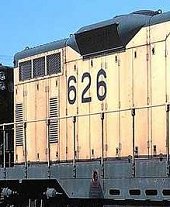 |
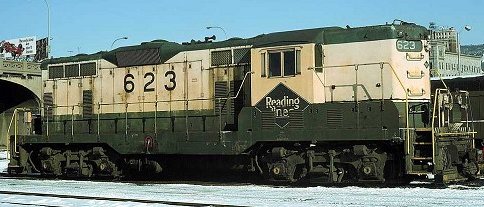 |
Below are some close up views of the short and long hoods of green/yellow GP-7s to show how the green paint was applied to the top of the locomotive. Note that on the long hood, the green paint is applied "around" the radiator screen, and that entire piece remains yellow. Also, on the end headlights, the top lens is green, while the bottom lens remains yellow, rather than painting the entire casing. Finally, note how the dynamic brake blister is treated, although there are some variations on this as well, as can be seen in the photo of #623 above. As with any modeling project, the best approach is to work from a prototype photo of the locomotive being modeled.
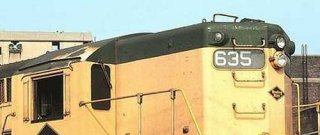 |
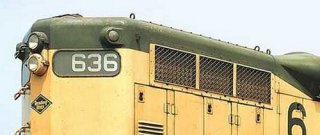 |
After an incident in Allentown Yard in 1973, Reading GP-7 #614 was repainted into the 1970s "Reading Green" paint scheme; this was the only unit to receive this paint scheme.
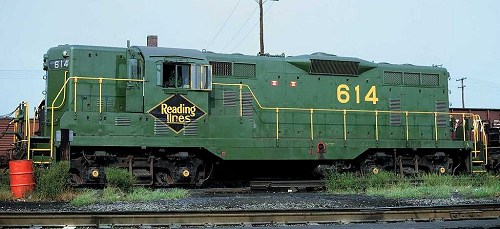 The Reading's GP-7s were truly "General Purpose" locomotives that served a variety of functions on the railroad, from mainline trains to branchline and yard service. They were favored by crews for their performance and reliability. The mix of paint schemes could add some color to your locomotive roster, and would demonstrate how the Reading's appearance changed over the later years. Given their numbers and longevity, the GP-7s are workhorses that would be at home on any Reading layout from the 1950s to the 1970s.
The Reading's GP-7s were truly "General Purpose" locomotives that served a variety of functions on the railroad, from mainline trains to branchline and yard service. They were favored by crews for their performance and reliability. The mix of paint schemes could add some color to your locomotive roster, and would demonstrate how the Reading's appearance changed over the later years. Given their numbers and longevity, the GP-7s are workhorses that would be at home on any Reading layout from the 1950s to the 1970s.
Did You Know?
Downloads
 A variety of Reading Company operations related documents, etc. that may be of use in your modeling efforts.
A variety of Reading Company operations related documents, etc. that may be of use in your modeling efforts.
 A variety of Reading Company operations paperwork, such as train orders, clearance forms, etc. that will help you operate your Reading layout in a prototypical manner.
A variety of Reading Company operations paperwork, such as train orders, clearance forms, etc. that will help you operate your Reading layout in a prototypical manner.
 Public Timetables, Employe Timetables, and Rulebooks that provide much useful operational information.
Public Timetables, Employe Timetables, and Rulebooks that provide much useful operational information.
 Signs, billboards, and other FREE goodies for your use. We ask only that you help spread the word about The Reading Modeler!
Signs, billboards, and other FREE goodies for your use. We ask only that you help spread the word about The Reading Modeler!

